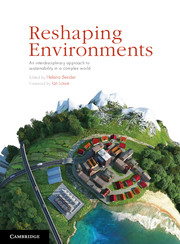Book contents
- Frontmatter
- Contents
- Contributors
- Acknowledgements
- Introduction Reshaping environments – an opportunity for envisioning the future
- Part 1 Cases
- 1 Costa Rica’s dry north-west
- 2 Reshaping land transport in Singapore
- 3 Evaluating different ways of managing forested landscapes
- 4 Changing the landscape management paradigm with farmers
- 5 Meeting development goals without blowing your carbon budget
- 6 The EGLE has landed
- 7 Reshaping the Murray-Darling Basin, Australia
- 8 Burning questions
- Part 2 Skills
- Part 3 Theory
- Index
- Plate Section
- References
3 - Evaluating different ways of managing forested landscapes
from Part 1 - Cases
Published online by Cambridge University Press: 05 February 2013
- Frontmatter
- Contents
- Contributors
- Acknowledgements
- Introduction Reshaping environments – an opportunity for envisioning the future
- Part 1 Cases
- 1 Costa Rica’s dry north-west
- 2 Reshaping land transport in Singapore
- 3 Evaluating different ways of managing forested landscapes
- 4 Changing the landscape management paradigm with farmers
- 5 Meeting development goals without blowing your carbon budget
- 6 The EGLE has landed
- 7 Reshaping the Murray-Darling Basin, Australia
- 8 Burning questions
- Part 2 Skills
- Part 3 Theory
- Index
- Plate Section
- References
Summary
Introduction
People want many different things from forests, such as timber, old growth trees, wildlife habitat, protection of water supplies, and a place for recreation. Individual people and groups often prioritise one or more of these outcomes; for example, environmental groups may see wildlife habitat as most important while people associated with the timber industry may prioritise timber production. In many parts of the world these different expectations for forests have resulted in social conflict. This is certainly the case in Australia, where there has been conflict between environmental and forest industry groups since the 1970s or earlier (Dargavel 1995). Reports of protests and delayed forestry operations are common, and more than one election outcome has been attributed to protest against government policy on forestry.
Forest management often seems a much entangled problem where managing in favour of one outcome can be achieved only at the expense of other outcomes. If forests are managed to protect old growth trees, there are fewer trees available to harvest for timber. If forests are logged for timber, this may compromise wildlife habitat and the visual beauty of the landscape. These dilemmas raise some challenging questions for people in the environmental planning sector. Do forest managers have to choose one outcome over another? Is it possible to develop forms of management that are socially acceptable, protect habitat and provide the timber outputs expected by many individuals and organisations? Is it possible to develop ways to manage forests that are acceptable to people with different expectations of forests?
Information
- Type
- Chapter
- Information
- Reshaping EnvironmentsAn Interdisciplinary Approach to Sustainability in a Complex World, pp. 65 - 81Publisher: Cambridge University PressPrint publication year: 2012
References
Accessibility standard: Unknown
Why this information is here
This section outlines the accessibility features of this content - including support for screen readers, full keyboard navigation and high-contrast display options. This may not be relevant for you.Accessibility Information
- 2
- Cited by
